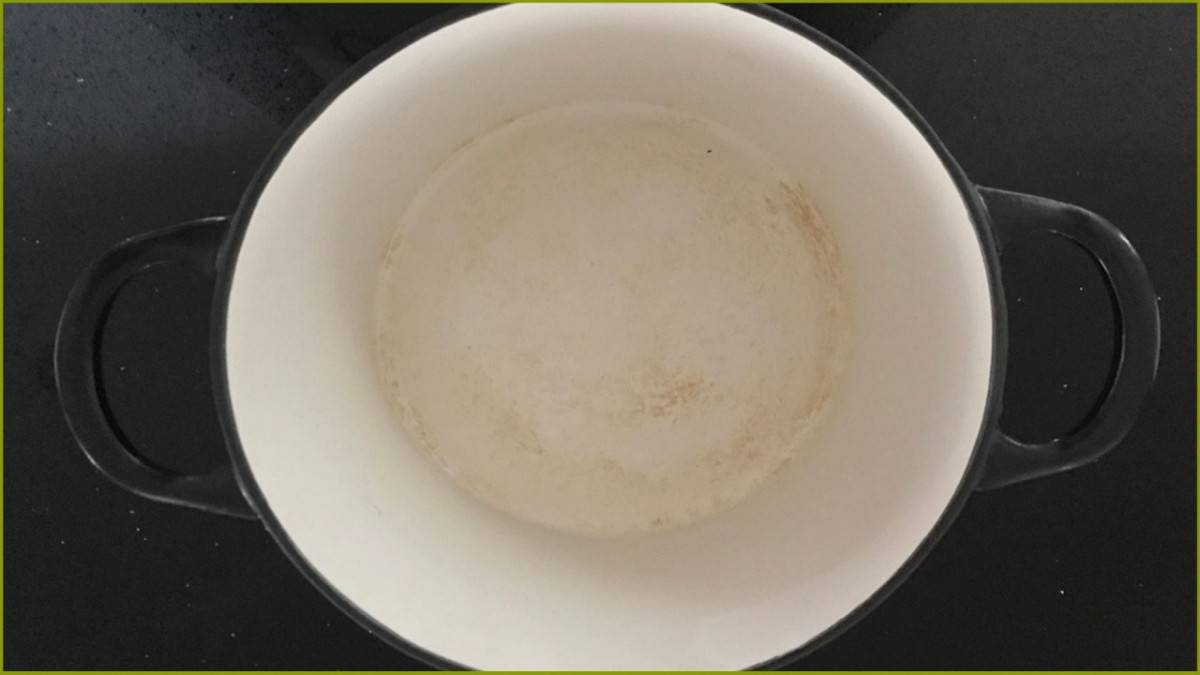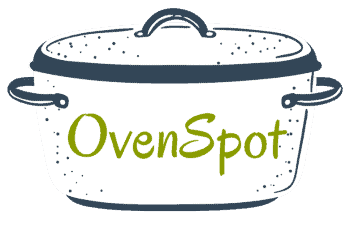Enameled Cast Iron Sticking? Stop It Sticking Today!
Ever wondered why over time the enamel on your cast iron cookware seems to wear down and stick? I was under the impression that enamel cast iron was considered a non-stick type of cookware! Boy was I wrong!
Is your enameled cast iron sticking? The reason your enamel cast iron is sticky or has food sticking to the inside of the enamel is that it is not a non-stick cooking surface. Combining a non-stick cooking surface, with the exceptional heat output from cast iron and not enough oil or other liquid is what makes it sticky over time.

Unlike seasoned cast iron cookware cast iron coated with enamel is not non-stick.
When you combine heat, improper use, certain food types, care, and maintenance this is when the sticky residue builds up over time, and cooking on the enamel becomes more difficult.
With a few simple steps, you can use your enamel cast iron without your favorite recipes sticking to the enamel.
Disclaimer: I earn from qualifying purchases on my website as an Amazon Associate. If you purchase through links from this website, I may get a small share of the sale from Amazon and other similar affiliate programs.
Why Does Your Cast Iron Enamel Cookware Stick
Enamel is Unseasoned
As I have already touched upon above enamel coating is not a non-stick surface, not like the man-made advertised non-stick options on the market these days. (Teflon along with others)
Seasoned raw cast iron is non-stick because it has a seasoned surface. Yes, this surface requires a little maintenance – but when maintained correctly it is the ultimate non-stick surface. (Just my opinion of course.)
Temperature
Cooking at high temperatures is a sure way to have sticking problems with an enamel pot.
To be fair if there is not enough oil used when cooking – for non-stick purposes, food can stick in any pot or pan if cooking at high heat.
Ingredients
Have you ever wondered what ingredients stain enameled cast iron?
There are certain types of food that will stick more than others these are food that will caramelize, stick and burn easily and quickly.
Some of these ingredients are:
- Tomatoes
- Wine
- Onions
- Garlic
- Honey
- Sugary Sauces
Must Read
“What not to cook in cast-iron” – I tell you what not to cook as well as “how to cook that food anyway” – here
Smelly cast-iron – check out this article for help.
It is not only the types of ingredients that stain the enamel but the cooking process itself. If you have any light-colored cookware it will not only absorb the color of foods that are cooked in it but also particles will stick and burn. So even when the food is removed and the pot cleaned well discoloration can occur.
Cooking Utensils
Cooking utensils ideally should be wooden, plastic, or silicone when preparing meals in an enamel cast iron pot or pan.
Metal will scratch or chip the enamel and this will be a base for all other particles/oil/burn/sticky buildup.
There is a lot of information out there about what utensils and accessories you need when preparing food with Dutch ovens. In my article here I have done all the work for you so you only have to purchase what you really need. A lot of pieces you will already have at home…
Season Enamel Before Cooking
As I have already touched enamel coating is not a non-stick surface, unlike the man-made advertised non-stick options on the market these days.
Enameled cast iron is semi non-stick not true non-stick for that reason the pot or pan needs to be seasoned generously with every use. By this, I mean lashings of oil to the bottom as well as up the sides of the pot, pan, or grill before heating your pan up.
This act alone will help stop food from adhering to the enamel.
In this article, you will learn all about cast iron and enamel cast iron and why it sticks, and in-depth preventative measures to make your cooking experience easier.
Temperature Control
When using any cast iron cookware you must remember its heat output properties.
Cast iron heats up slowly but when it is hot it retains heat like no other piece of cookware you will ever use. For this reason, you should use the following steps to heat up your cookware before putting any food inside to cook.
1. Liquid
Put oil, broth, or water into the bottom of the pan or pot. Be generous.
2. Heat Source
Heat up the pan over low heat.
You can increase to medium heat if you want to sear, saute or fry.
You need to remember that even at low heat the oil or other liquid will become very hot so when inserting ingredients you need to be prepared for splatter.
3. Increase Heat
Once you have inserted your food into the liquid you can then start to raise the heat if you require the pot or pan to be hotter.
Tip – Remember if your pot or pan gets too hot just reducing the heat will not cool it down quickly. Turn the heat off and remove it from the burner. You can also stir to avoid sticking while the pot cools down a little.
After Meal Preparation
Letting food dry onto the pot makes your job harder when it comes time to clean.
Remove all the food as soon as you can after cooking. When the pot has cooled you can fill it with water and let it soak.
Tip – When your cast iron is hot – seasoned or enamel – NEVER pour cold water onto it. It could be damaged by a thermal shock reaction. Think of an icy cold glass inserted into hot water – cracks and or shattering.
Care and Maintenance
It can also look dull and lifeless even if there are no burn or sticky food particles visible on the enamel.
This dull look comes about over a period of time and the contributing factors are:
- Not enough liquid covering the enamel
- Sticking – heat to high
- Utensils
- Acidic food
- Cleaning
Removing Stains from Enamel
Stains can be removed from light-colored enamel. You should remember that enamel ages and pots that are well used even with gentle loving care – will stain lightly.
Remember to always avoid abrasive cleaners on enamel cast iron. Think of motor vehicle paint and what rubbing steel wool over that would do!
1. Warm Soapy Water
Start with warm soapy water and a sponge or nylon scrubber – gently scrub and remove as much as you can of the sticky burnt-on particles.
Does the discoloration need more attention? You can use 3 tablespoons of baking soda in the pot filled with 1/2 to 3 quarts full of water and simmer for 10 to 15 minutes. Turn the heat off and let the pot cool down completely.
When cool empty the pot and wash/scrub again with soapy water.
Hopefully, you now have the desired result. If not repeat it again.
2. Dry That Pot
Do not think that because you have an enameled covered cast-iron pot it cannot be susceptible to rusting. If the enamel is compromised in any way rust will grow.
After washing dry thoroughly with a soft towel. Better still you can place the pot in a warm oven for a few minutes which will totally dry it out before storing it.
Washing and drying cast-iron by hand to avoid rust is one of the main reasons you should not put cast-iron in a dishwasher.
The steam drying action of a dishwasher does not help to preserve cast-iron nor do the abrasive cleaners used in the soap – see more about cast-iron and dishwashers – here.
3. Shine Enamel Surface
Enamel will dull over time.
You can use your oil of choice and rub it all over the pot inside and outside and don’t forget the lid if you have one.
Then with a soft cloth wipe off any excess oil then buff the pot all over inside and out. You will be surprised at the result.
In my article, you find many variations of ways to clean and restore enamel cast iron pots.
Is Le Creuset Enamel Non Stick?
Le Creuset is a well-known brand that produces high-quality cookware. One of its most popular product lines is its enameled cast iron cookware.
The enamel coating on Le Creuset’s cast iron pots and pans is not “non-stick” in the same sense as Teflon or other non-stick coatings. Instead, it provides a smooth, durable surface that resists staining and can handle high heat. This enamel surface is less prone to sticking than bare cast iron, but it doesn’t have the same non-stick properties as modern non-stick pans.
However, with proper pre-heating and using some oil or fat, food can be cooked in an enameled pan with minimal sticking. Additionally, one of the benefits of enameled cast iron is that it can develop a good sear on foods like meat, which can be more difficult in some non-stick pans.
In summary! Le Creuset’s enameled cookware is not “non-stick” in the traditional sense. However, with proper pre-heating and the use of oil, food can be cooked in an enameled pan with minimal sticking.
Using these techniques enhances its performance and offers a durable and versatile cooking surface with some resistance to sticking. Learn how to care for Le Creuset enamel cast iron cookware!
Final Thoughts – Enameled Cast Iron Sticking?
Caring for your enamel cast iron takes a little care and work. But you can clean and restore it if it does become sticky.
Use the tips above and you will find that your food adheres to your cooking pot a lot less than previously.
One-Pot Cooking Rocks!

Michelle
Hi, I’m Michelle, the founder, owner, author, and editor of OvenSpot. My passion for one-pot cooking commenced when I was working to prepare cafeteria lunches for school students. I am now on a mission to assist you in choosing the cooking pot or appliance you will use daily. As well as in-depth information to assist you in using and caring for your cookware and appliances.
Questions? Reach out to Michelle at [email protected]
